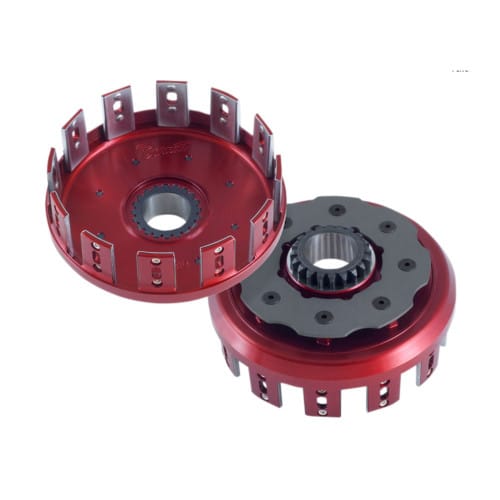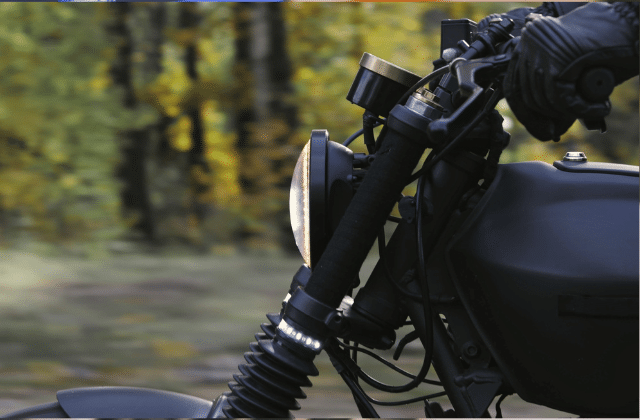How Does a Clutch Work on a Motorcycle – EXPLAINED

As motorcycle riders, one of the first things we learn is how to use the clutch on our bikes to shift gears, and the pattern of engaging the clutch, changing gears, and then disengaging the clutch again becomes a natural process we perform so often that it’s hard to get it wrong eventually.
What we don’t think about when we’re first learning, though, is how the clutch is actually doing its job. This is the sort of thing that gets taken for granted most of the time; we just know that it works without worrying about the how. Most of us are just riding around without understanding one of the most critical parts of our bike!
Understanding how something works can be a huge help when you’re using it, and in this article, we’ll dive into what’s really going on with the clutch when we’re shifting. We’ll also go over some basic tips to make sure that your clutch lasts longer, and that means more time riding and less time in the shop.
Table of Contents
How Does the Clutch Work on a Motorcycle?
Let’s start with what a clutch actually does. When your bike’s engine is running, the pistons are constantly in motion, producing power which is then transferred to the gearbox and then sent from there to a chain, belt, or driveshaft, which drives the rear wheel. The neutral gear allows the bike to idle without moving forward by having many of the gears spinning free without driving anything.
Shifting the transmission engages those gears so that you can get moving. The clutch is a critical part of this step in the process.

You see, if the engine were always sending power to the transmission, then when we tried to shift out of neutral the spinning components would have a hard time engaging with one another, and more than likely break. The clutch keeps this from happening by momentarily stopping the transfer of power from the engine to the transmission’s input shaft.

- Primary Drive Gear and Clutch Basket: This component is driven by another gear which is connected to the engine. (See image to the right)
- Friction Discs: These discs have teeth on the outside which connect to the clutch basket. These discs “grip” the clutch plates (more on these below) when the clutch is engaged and make them spin along with the rest of the assembly. These are the first half of what is called the “clutch pack.”
- Clutch Plates: Clutch plates sit between the friction discs and are usually made of a material like steel. Teeth on the inside of the clutch discs turn an inner gear that is connected to the transmission’s input when the clutch is engaged. The plates are the second half of the “clutch pack.”
- Clutch Springs: Clutch springs press the pressure plate to the friction discs, which squeezes them up against the clutch plates, and this “engages” the clutch.
- Pressure Plate (or Clutch Cover): A pressure plate works along with the clutch springs to compress the plates and friction discs together.
- Clutch Lifter: The clutch lifter pushes the pressure plate and releases the pressure that holds the clutch plates and friction discs together.
When the clutch is engaged, that is, when you aren’t pulling the clutch lever, the whole assembly is spinning. This transfers the energy from the engine to the assembly, which transfers it to the transmission’s input shaft.
Disengaging the clutch by pulling the clutch lever releases the tension holding the friction discs and clutch plates together, and that lets the plates spin freely. Because the plates are the only component driving the transmission’s input shaft, no power is transferred to the transmission.
Releasing the clutch lever lets the friction discs squeeze the clutch plates again, getting them moving and continuing the transfer of power to the transmission.
So to recap:
The engine’s output spins the clutch basket, which contains the friction discs. When the clutch is engaged, the friction discs grip and spin the clutch discs which turn a gear that is connected to the transmission’s input shaft.
When you pull the clutch lever, the tension held on the clutch pack via the clutch springs and pressure plate is released by the clutch lifter, letting the clutch plates spin freely without transferring power to the transmission.
How to Ensure Your Clutch Lasts a Long Time
The clutch is considered a “wear item” on a motorcycle. This means that it will eventually wear down and need to be replaced eventually. Even though the clutch will wear out, there are several things you can do to make sure that it lasts as long as possible.
Do your oil changes on time

The overwhelming majority of motorcycles on the road employ what is called a “wet clutch.” A wet clutch is bathed in the engine oil to cool the clutch and keep the moving parts lubricated. Because of this, your engine oil’s health can also affect your clutch’s health and longevity.
Making sure you use high-quality engine oil and making sure you do your oil changes on schedule both go a long way to increasing the lifespan of all of the bike’s moving parts, the clutch included.
Practice good clutch control
Having good control of the clutch may seem like an obvious way to make your clutch last longer, but you may be surprised by some of the bad habits a lot of riders pick up without even realizing it.

For maximum longevity, you should always be smooth with disengaging and reengaging the clutch. Quick, jerky movements with the clutch lever result in very sudden movements in the clutch, and that can be very hard on the clutch. Rounded teeth in the clutch plates, overheating, and even premature wear.
Some riders also get into the habit of keeping a hand on the clutch lever. Riding the clutch in this way can also speed up the wear on the clutch components, including the clutch springs, clutch pack, and even the pressure plate. It’s a good practice to only ever touch the clutch lever when you need to use the clutch.
Remember to practice the smooth clutch technique and you will find that your clutch will last substantially longer.
Ride Smart
Aside from being extremely dangerous, aggressive riding and pulling tricks on the road can also wear out the parts on your bike, especially the clutch.
A lot of the more popular stunts on a bike involve aggressive and sudden use of the clutch, and that increases wear and the chance for damage. Rapid and aggressive shifting, especially downshifting, can wear the clutch out as well and for the exact same reason.
Riding responsibly is not only much safer but it also doesn’t wear your bike out nearly as quickly as engaging in bad behavior does. That means more time riding and less time in the shop, or the hospital, for that matter.
Clutch Types – Wet vs. Dry
As pointed out earlier, most motorcycles have a “wet clutch,” which is bathed in engine oil to keep it cool and lubricated. This design is very effective but can have its drawbacks as well.

Because it shares oil with the engine, the oil can collect debris that is shed from the wear and tear on the clutch, and that dirties the oil more quickly, and a serious problem with the clutch that creates larger chunks of debris could even damage the engine in extremely rare circumstances.
A “dry clutch” system, by comparison, doesn’t spin through an oil bath. This leads to some advantages in performance. Firstly, since the clutch doesn’t run through the engine’s oil, there is no risk of contaminating the engine oil with dust and debris from the clutch.
The spinning clutch also doesn’t encounter the oil’s resistance with a dry system, resulting in a better-performing system.
The drawback to a dry clutch is reduced life since it is not cooled or lubricated as effectively as a wet clutch. This increased reliability does not heavily compromise the clutch’s performance, and because of the benefit of longevity, most motorcycle manufacturers favor a wet clutch system over a dry one.
Frequently Asked Questions
What happens when you squeeze the clutch lever on a motorcycle?
Squeezing the clutch lever causes the clutch lifter to press onto the clutch’s pressure plate, relieving the pressure that presses the clutch pack together. When the pack is decompressed, the friction discs are no longer squeezing the clutch plates, allowing the plates to spin freely.
This process effectively disconnects the power coming from the engine from the transmission and allows the safe changing of gears.
How does a dry motorcycle clutch work?
A dry clutch trades cooling, lubrication, and ease of use for performance by operating without the oil bath that a wet clutch relies on. They engage far more aggressively, heat up much more quickly, and are generally more difficult to use but deliver power more effectively.
Because of their focus on performance, some high-performance machines, such as the Ducati Panigale, use dry clutches, where performance is considered more important than reliability.
Should you always start a motorcycle with the clutch in?
When starting a bike, having the clutch pulled in is actually not critical. What is important is that power is not being delivered to the rear wheel. While this can certainly be accomplished by starting the bike with the clutch pulled in, you can also start the bike in neutral with no need to be holding the clutch.
Conclusion
The clutch is a part of any motorcycle that gets a lot of use, with or without understanding its ins and outs. In this article, we’ve taken a close-up look not just at what the clutch does but how it does it.
Knowing what’s going on when we pull the clutch lever is a strong step to better riding, whether on the road or the track. Better riding means a better experience and less time and money spent on repairs.
Whether you’re just getting started or you’ve been riding for years, there’s always room to improve – the first step is always more knowledge.
